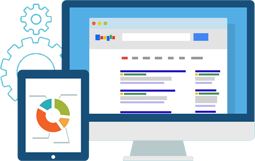
Using Customer Behavior to Improve Web Design
Today’s digital zeitgeist obligates websites to play a crucial role in the success of any Los Angeles online business. That’s because a well-designed and fully functional website attracts and retains customers, increases brand awareness, and leads to higher sales if created properly!
However, as you may imagine, designing a website that meets the needs and expectations of your target audience can be tricky to get just right. To achieve this, it’s important to understand customer behavior and use this data to improve your Los Angeles website design to make the most out of everything.
Here are some ways to do so:
1. Analyze Website Data
Website analytics tools such as Google Analytics can show you very valuable insights into the behavior of your customers. This includes how visitors interact with your website, which pages they visit most frequently, and how long they stay on each page. Using this knowledge, you can determine areas of your website that do very well and areas that need improving.
For example, visitors leaving your website after a few seconds on a particular page may indicate that it is not engaging enough or lacks relevant content. What’s driving them away? What seems to be lacking? Then, you can rectify things like add internal links or calls to action to try and compel viewers to stay longer.
2. Conduct User Research
User research can help you figure out your target audience’s needs, preferences, and pain points. There are various ways of doing this like surveys, focus groups, and user testing, to collect data on how users interact with your website. Each of these examples has their own benefit.
Look at the results of the research and use it to look for mundane things around the website you don’t really think about, like perhaps a navigation system that can be improved, or a layout that is too cluttered.
3. Create User Personas
User personas are fictional characters that represent your target audience and help you better understand your customers’ needs, motivations, and behavior. It’s like creating characters in a storybook and giving them characterization! By creating these user personas, you can design your website with them in mind and their specific needs, improving user engagement and satisfaction.
For example, if your target audience is primarily older adults, design your website with larger fonts and more straightforward navigation to accommodate their needs, because you imagine they’ll have harder time seeing tiny fonts or understanding a menu.
4. Use A/B Testing
A/B testing is creating two different webpage versions and randomly showing them to users to determine which version performs better. See what web page works better by comparing user behavior on each, then figure out why. Are there design elements that are more effective in engaging and converting visitors? Improve the overall design of your website using the data you uncover.
5. Optimize Website Speed
Website speed is critical to user engagement and satisfaction, and we mean it! Slow-loading websites can lead to high bounce rates and reduced conversions because nobody has the time to wait in this fast-paced world. Optimizing website speed can improve user experience and increase the likelihood of visitors returning to your website because they can see you’re reliable. Some ways to optimize website speed include optimizing images, minimizing code, and leveraging browser caching.
Conclusion
In conclusion, understanding customer behavior is critical to design and improve a website that meets their needs and expectations. By following the steps we’ve highlighted in this article, you can improve user engagement and satisfaction, ultimately leading to higher sales and increased brand awareness.
If you’re looking for more ways to retain customers and create the best version of your website, consider partnering with Drive Traffic Media, a long-time digital marketing agency in Los Angeles. Call us at (949) 800-6990 or (310) 341-3939 to find out what we can do for you.

